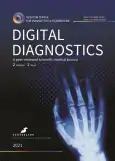MRI evaluation of the neoadjuvant chemoradiation therapy result in a patient with rectal cancer, supplemented with T2-WI texture analysis of the tumor: a clinical case
- Authors: Dayneko Y.A.1, Berezovskaya T.P.1, Myalina S.A.1, Orekhov I.A.1, Nevolskikh A.A.1
-
Affiliations:
- А. Tsyb Medical Radiological Research Centre – branch of the National Medical Research Radiological Centre
- Issue: Vol 2, No 1 (2021)
- Pages: 67-74
- Section: Case reports
- URL: https://journals.rcsi.science/DD/article/view/60493
- DOI: https://doi.org/10.17816/DD60493
- ID: 60493
Cite item
Abstract
The article presents a clinical case of using the active follow-up strategy (the so-called watch & wait) in a 73-year-old patient with cancer of the lower rectum with a good response to neoadjuvant chemoradiation therapy (NCRT). After 3 years of regular follow-up, including digital rectal examination, rectoscopy and MRI, indicating the absence of tumor progression, PET/ CT with 18F-FDG was obtained, which revealed a region of hypermetabolic activity in the lower rectum (SUVmax 27.1), in connection with which it was decided to carry out surgical treatment. When discussing the issue of the volume of the operation, MRI data were taken into account, supplemented by the results of T2-weighted texture analysis, which confirmed the absence of progression. The patient underwent organ-preserving treatment in the amount of transanal tumor resection. Pathomorphological examination after surgery established the inflammatory changes in the intestinal wall and absence of tumor. This case demonstrates the effectiveness of the standard examination volume when using the watch & wait strategy and the possibility of using T2-WI texture analysis to increase the reliability of MRI assessment of tumor response to chemotherapy.
Full Text
##article.viewOnOriginalSite##About the authors
Yana A. Dayneko
А. Tsyb Medical Radiological Research Centre – branch of the National Medical Research Radiological Centre
Email: vorobeyana@gmail.com
ORCID iD: 0000-0002-4524-0839
SPIN-code: 1841-7759
MD, Research Associate
Russian Federation, 4 Korolev st., Obninsk, 249036Tatiana P. Berezovskaya
А. Tsyb Medical Radiological Research Centre – branch of the National Medical Research Radiological Centre
Author for correspondence.
Email: berez@mrrc.obninsk.ru
ORCID iD: 0000-0002-3549-4499
SPIN-code: 5837-3465
MD, Dr. Sci. (Med.) Professor, Chief Researcher
Russian Federation, 4 Korolev st., Obninsk, 249036Sofia A. Myalina
А. Tsyb Medical Radiological Research Centre – branch of the National Medical Research Radiological Centre
Email: samyalina@mail.ru
ORCID iD: 0000-0001-6686-5419
MD, Junior Research Associate
Russian Federation, 4 Korolev st., Obninsk, 249036Ivan A. Orekhov
А. Tsyb Medical Radiological Research Centre – branch of the National Medical Research Radiological Centre
Email: ivan.orekhov.vgma@gmail.com
ORCID iD: 0000-0001-6543-6356
SPIN-code: 6040-8930
MD, Junior Research Associate
Russian Federation, 4 Korolev st., Obninsk, 249036Aleksey A. Nevolskikh
А. Tsyb Medical Radiological Research Centre – branch of the National Medical Research Radiological Centre
Email: nevol@mrrc.obninsk.ru
ORCID iD: 0000-0001-5961-2958
SPIN-code: 3787-6139
MD, Dr. Sci. (Med.)
Russian Federation, 4 Korolev st., Obninsk, 249036References
- Fedyanin MYu, Artamonova EV, Barsukov YuA, et al. Practical recommendations for the drug treatment of rectal cancer. Malignant tumors: Practical recommendations of RUSSCO. Russian Society of Clinical Oncology; 2020. (In Russ). doi: 10.18027/2224-5057-2020-10-3s2-23
- Gillies RJ, Kinahan PE, Hricak H. Radiomics: images are more than pictures, they are data. Radiology. 2016;278(2):563–577. doi: 10.1148/radiol.2015151169
- Haralick RM, Shanmugam K, Dinstein I. Textural features for image classification. IEEE Transactions on Systems, Man, and Cybernetics. 1973;SMC-3(6):610–621. doi: 10.1109/TSMC.1973.4309314
- Berezovskaya TP, Dayneko YaA, Nevolskikh AA, et al. A system for evaluating the effectiveness of neoadjuvant chemo radiotherapy in patients with colorectal cancer based on a texture analysis of post-therapeutic T2-WI magnetic resonance imaging. REJR. 2020;10(3):92–101. doi: 10.21569/2222-7415-2020-10-3-92-101
- Lambregts DM, Rao SX, Sassen S, et al. MRI and Diffusion-weighted MRI volumetry for identification of complete tumor responders after preoperative chemoradiotherapy in patients with rectal cancer: a bi-institutional validation study. Ann Surg. 2015;262(6):1034–1039. doi: 10.1097/SLA.0000000000000909
- Lambin P, Rios-Velazquez R, Leijenaar S, et al. Radiomics: Extracting more information from medical images using advanced feature analysis. Eur J Cancer. 2012;48(4):441–446. doi: 10.1016/j.ejca.2011.11.036
- Horvat N, Veeraraghavan H, Pelossof RA, et al. Radiogenomics of rectal adenocarcinoma in the era of precision medicine: A pilot study of associations between qualitative and quantitative MRI imaging features and genetic mutations. Eur J Radiol. 2019;113:174–181. doi: 10.1016/j.ejrad.2019.02.022
Supplementary files













